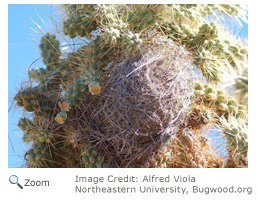Diet

The cactus wren forages for food on the ground. It uses its long bill to turn over things on the ground. It eats ants, beetles, grasshoppers, wasps, fruits and seeds. Sometimes it will eat small frogs and lizards. It is adapted for life in the desert and gets most of the water it needs to survive from the food it eats.
Life Cycle
Cactus wrens mate from late February to March. Cactus wrens can have as many as three broods every season.
 Females find a nesting place in a large cactus or thick shrub, tree or thicket. Males help build the nests. The nest is made with grass and straw and lined with feathers. The nest is large and shaped like a football. It has a side entrance that helps protect the fledglings from predators.
Females find a nesting place in a large cactus or thick shrub, tree or thicket. Males help build the nests. The nest is made with grass and straw and lined with feathers. The nest is large and shaped like a football. It has a side entrance that helps protect the fledglings from predators.
The female lays between three to six eggs. The eggs take a little more than two weeks to hatch. The young wrens leave the nest after about three weeks, but they depend on their parents for food for another month.
Behavior
Cactus wrens build two nests - one for their young and one for roosting.